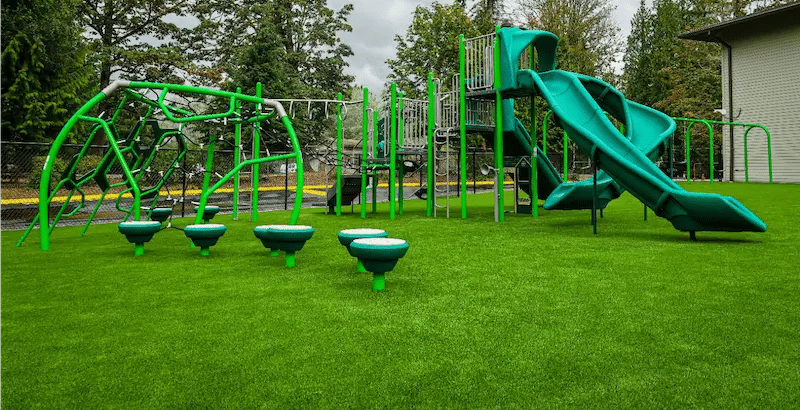Playgrounds are spaces where children explore, exercise, and develop social skills. Yet, they are also environments where falls, bumps, and scrapes frequently occur. For families and communities in Tampa, the surface beneath playground equipment has a significant influence on how safe children remain while they play. Synthetic turf has emerged as a modern surface option that offers consistent safety, durability, and long-term value. By combining advanced materials with practical benefits, this surface supports both protection and play.
The Science of Softer Landings
Children often climb, run, and jump in ways that lead to tumbles. A safe playground surface helps reduce the severity of those falls. Artificial turf systems designed for play areas include shock-absorbing pads or underlayers that cushion impact. These materials help soften landings from common playground heights, such as slides or climbing frames.
The height and density of turf fibers, combined with the type of infill used, also influence safety. Infill provides stability while keeping the surface springy enough to absorb energy. Together, these features help limit injuries and create a more consistent play surface than grass, mulch, or sand.
Cleaner and Healthier Play Spaces
Traditional grass or loose surfaces can introduce a range of irritants. Grass pollen, fertilizer residue, and pesticides may lead to discomfort for children with allergies or sensitive skin. Dirt and mud can spread quickly, making playgrounds messy after rain.
Synthetic turf eliminates the need for chemical lawn treatments, reducing exposure to irritants. Many turf systems are manufactured with non-toxic, lead-free materials. Some even incorporate antimicrobial infill to discourage the growth of bacteria or mold. Combined with built-in drainage that prevents standing water, these features support a healthier play space that requires less cleanup.
Durability in High-Traffic Areas
Playgrounds receive constant use. Over time, natural grass becomes worn down, especially in high-traffic spots beneath swings or at the bottom of slides. Bare patches, uneven surfaces, and muddy areas are common. Loose materials such as wood chips must be replenished regularly, which adds to upkeep costs.
Artificial turf withstands heavy use without the same wear and tear. Turf fibers are designed to bounce back after compression, maintaining a level and attractive surface even in high-use areas. Ultraviolet inhibitors protect the material from sun damage, while efficient drainage ensures that heavy Florida rains do not create lasting puddles or erosion. This resilience helps ensure playgrounds remain open and usable throughout the year.
read more : 7 Best Virtual Team Celebration Ideas for Work
Meeting Playground Safety Standards
Playground surfacing is often evaluated according to established safety standards, including those that measure impact absorption. Many artificial turf systems are tested to comply with these requirements, demonstrating that they provide adequate protection for falls from typical equipment heights.
Schools, municipalities, and park managers benefit from selecting surfaces that meet these standards because compliance provides peace of mind for families. Knowing that the material has been independently verified for performance strengthens confidence in its ability to support children’s safety.
Visual Appeal and Financial Considerations
A playground’s appearance influences how inviting it feels to families. Artificial turf provides a consistent, green surface that remains vibrant year-round. Unlike grass, it does not brown in the summer or develop bare patches in shaded areas. Unlike mulch, it does not scatter or decompose. The neat, uniform look of turf creates a welcoming environment where children and parents alike feel comfortable.
While installation involves an upfront investment, the reduced maintenance demands deliver value over time. There is no need for mowing, watering, or chemical treatments. Labor and material costs associated with replenishing mulch or repairing worn grass areas are eliminated. Additionally, the extended lifespan of synthetic turf compared to many traditional surfaces supports long-term cost efficiency for schools and municipalities.
Supporting Inclusive Playgrounds
Playgrounds are increasingly designed to welcome children of all abilities. A smooth, level, and firm surface provides better accessibility for wheelchairs, walkers, and strollers. Artificial turf supports these needs more effectively than gravel, sand, or uneven natural grass. This feature allows families to share play experiences together, reinforcing the role of playgrounds as community gathering spaces.
From reducing the severity of falls to promoting cleaner and more durable play areas, synthetic turf offers substantial advantages for modern playground design. Families in Tampa benefit from safer environments where children can play freely, while schools and municipalities appreciate the reduced maintenance and reliable performance. For expert guidance on playground installations and other applications, contact Artificial Turf Tampa to learn how synthetic turf can enhance your community spaces.
